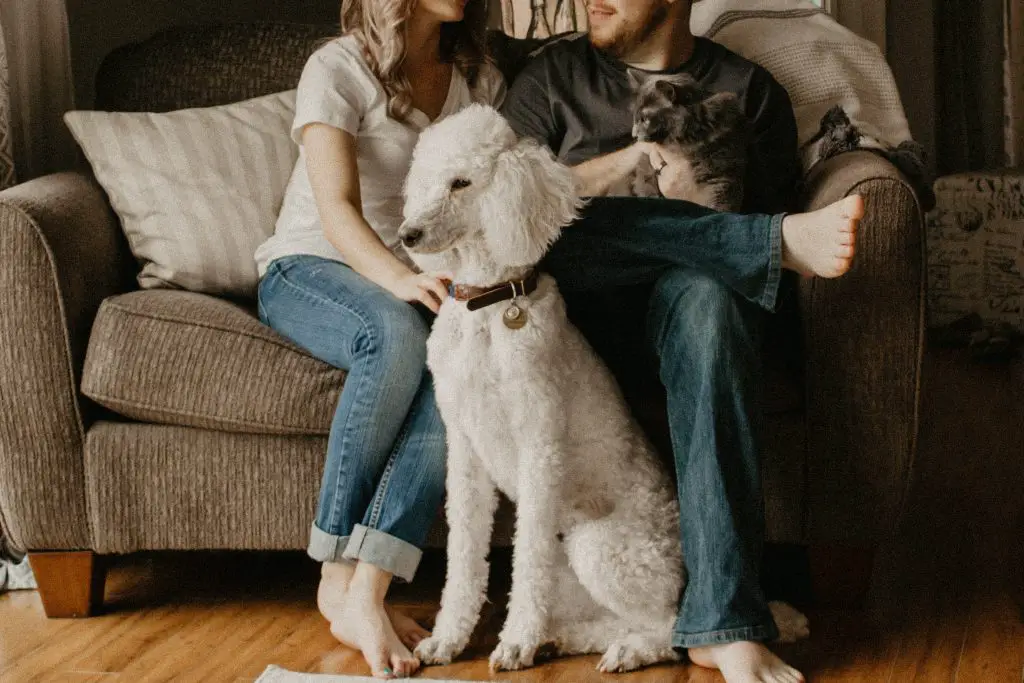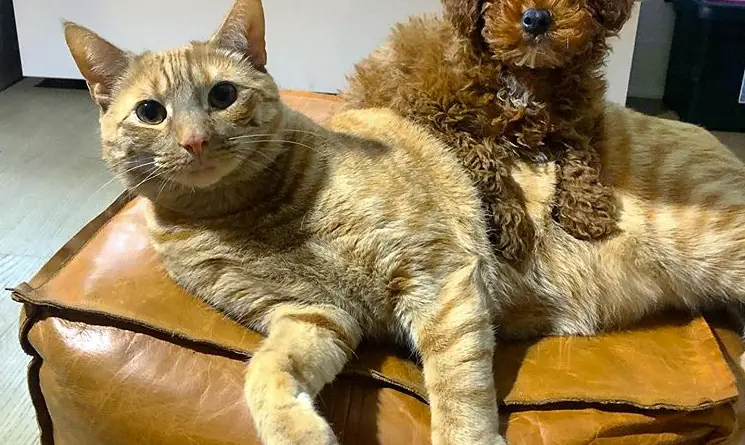Are Poodles Good With Cats? How To Get Your Poodle And Cat To Love One Another

Toy poodles, miniature poodles and standard poodles are known for their fluffy fur and majestic stance. They are intelligent, loving, and loyal pups! There are a few different sizes of poodles to choose from also. Regardless of the size, poodles are known for being a great breed to have alongside feline friends. Poodles are smart and can usually be trained fairly easily. Because of this, they are often known to be pretty good with cats. Of course, every dog is a little different so there will always be cases where a poodle and cat may not be completely compatible.
So, are Poodles Good With Cats?
Poodles are good with cats compared to other less cat-friendly dog breeds. While like all dog breeds, there can be individual poodles who are scared of cats or don’t like them. However, generally because poodles tend to be calm and intelligent, they are able to live with cats perfectly happily.
Toy poodles, miniature poodles and standard poodles are all equally good with cats as they share the same personality and traits of their breed. Having said that, some people swear that standard poodles are the calmest, so don’t be put off thinking their large size will be bad around a cat.
Toy poodles, miniature poodles and standard poodles are known for being quite calm and intelligent. They will be loyal, loving, and even protective if the situation arises. Depending on your specific poodle, some are known to even be protective of their cat brother or sister and there are thousands of poodle and cat owners who can vouch for how much poodles and cats love each other.
Poodles are known to be very loving and attached to their family members and this is often extended to all pets in the home. They also do not have the same type of hunting instinctive tendencies as other dog breeds such as greyhounds or Siberian Huskies, and are mostly only attracted to hunting ducks, you can read more about the poodle’s hunting history here. This makes them a great match for having a cat because in most cases your poodle is probably not going to try to be aggressive in any way towards your cat. Even if your poodle is spending time outdoors and encounters a wild cat, they will likely not try to hunt them. In reality your poodle is more likely to be a bit scared of a cat than attack one. Though if you do notice your poodle really enjoys chasing cats, or on the other end of the spectrum, appears to be scared of them during walks outside, it may not be the best idea to get a cat for your home.
What To Think About Before Adopting a Poodle or a Cat
When you are considering adopting a cat or adopting a dog, regardless of which you have first, it’s important to consider your animal’s specific personality. While poodles and cats can get along quite well, there are certain situations where this could not be the case. For example, if you have a shy cat that may be a little more timid than most, you would probably not want to adopt a dog that is extremely energetic. While poodles are not hyperactive dogs, when they are younger and puppies, they do have a lot of energy and will often get “zoomies” where they run around, playing and making a lot of noise. That said, it’s easier to train a puppy to behave around cats than an older dog.
Of course, you can still choose to adopt an energetic pup, but the training process might be a little tougher for both parties. Your poodle will need to learn to be respectful of the cat and the cat will need to learn to be more tolerant of the new family member.
Alternatively, some cats can be quite dominant and territorial, especially if they are old and have always been king or queen of the castle. If a cat is like this it can result in a new puppy being bullied by the cat which is not good. If your cat is like this it may be best to avoid bringing any more pets into the home altogether and waiting until the time is right.
How to Introduce Your Cat and Poodle

When you are trying to choose where you will introduce your pets (before adoption) it’s usually not the best practice to bring either animal to a shelter. The environment of a shelter can be extremely stressful for both of your fur babies, so this is not the best place for them to get to know each other. If you are adopting a new dog or cat, you can try to see their interactions with (the opposite pet) at the shelter. For example, if you are adopting a dog, you can ask one of the employees at the shelter to bring a cat into a meeting room to see their interaction. Of course, this will not be the exact same cat, but it’s usually a good indicator if your dog will revert to any hunting instincts.
How to Prepare Your Cat, Poodle, and Home
Before you introduce the cat and poodle there are a few basic things you should do.
The first is trim your cat’s nails, this is to stop your cat hurting your poodle upon meeting. If you don’t know how to do this, ask your vet for advice as the last thing you want is to hurt your cat’s paws. Cats can be nervous around dogs understandably, and sometimes even if there is no reason for it they can become scared and lash out with their claws. If your cat hurts your poodle, it can either frighten your poodle or make your poodle be aggressive back to your cat- a lose lose situation!
The second (though no less important) is to take your poodle for a very long walk to tire them out. This will reduce the risk of your poodle having a burst of hyperactivity when they first meet the cat. If your poodle is very hyperactive when they first meet the cat it can make a very bad first impression- and first impressions count!
Make sure your cat has somewhere safe they can go to to hide from your poodle if they need to. All cats need a hidey place for when they need alone time, but it is even more important when they are in a new and potentially overwhelming situation- such as meeting a new poodle. Having somewhere safe to go will offer your cat great comfort and security.
It is also worth making sure that every room has a high surface for the cat to jump on that your poodle won’t be able to, to get away from the poodle if they do end up chasing one another. A cat post would do the trick and would be a worthwhile investment to make your cat feel safer around the poodle.
As well as space for the cat, your poodle also needs a safe space to go and retreat to. This can be a crate or a corner where they will not be disturbed.
It is best to keep your poodle and cats things separate. For example, keep the cat and poodle’s food and drink separate, so they do not end up fighting for space to eat and drink. Keep the cat’s litter tray sperate as cats can feel unsafe and vulnerable while they are using it and won;t appreciate an intruder during their time in the litter tray. Keep the litter tray behind a gate to stop this happening, but also to stop your poodle trying to get into the litter tray to sniff the cat’s poo (or worse, eat it!).
Introducing Your Cat and Poodle For The First Time
When introducing any dog and cat, there are a few steps that should be taken to make sure they have the best experience possible. The Best Friends Animal Society recommends three methods of introducing dogs and cats. You can decide which method will work best for the personalities of each of your furry friends. The three methods are introducing slowly through desensitizing your animals, straight forward meeting, and teaching your pup to not focus all of their attention on your cat.
A good thing to do before all cat and poodle meetings is get them used to each other’s scents. Both cats and dogs use their sense of smell way more than humans and becoming more familiar with a smell can help both your poodle and cat get to know each other before actually meeting in person. Put one of your poodle’s toys in the cat’s basket and vice versa a few days before their real meeting.
The first type of introduction is slower, which may be better if your poodle or cat tends to be hesitant, nervous, or anxious in unknown situations. This method includes keeping your fur babies separated and slowly introducing them. This can be by keeping them in separate rooms (with a door to close) or with a baby gate, slowly building up to an introduction with your poodle in a crate before finally opening the door. The desensitization process will depend on your specific situation, but this can be a great way to get both animals to feel comfortable with the new family member.
On the other hand, with a more straight forward meeting, you can have your poodle on a leash and let the animals introduce themselves. With this method, it’s important to pay attention to how both of your furry friends are feeling with the encounter. Some signs to look for are ears pinning back, retreating, or meows or barks that signify fear or stress.
The last option is for if you are having trouble keeping your poodle from being too fixated on your new cat. You can teach them to be less interested in your cat by training them to focus on other things. This can be done by focusing your dog’s attention on something else when they are fixated on the cat. This can be done with rewards for your pup such as treats, bones, or toys. During this process, it is best to make sure that our animals are not alone together without you being present. This is mainly for safety reasons. Although, it’s also a great rule to follow because you will start to pick up on the habits of both of your pets through observation.
After you try one of these methods you can try letting your pets interact with one another without you present. It would be best to still be home, in case any disagreements break out. But this allows your furry friends to get acclimatized with each other in their own time. According to the American Humane Society, it’s best to wait about a month before allowing your pets to do this. If you notice that either one of your fur babies is acting strange or not adjusting property, you may want to consider bringing your pets to a veterinarian or specialist. Usually, this will not be necessary but there are always cases where a specific pet can be more sensitive than most and may have a more difficult time adjusting.
If you see or hear your poodle and cat fighting at any point, you should intervene so neither gets hurt. Calmly remove them from the room and allow them to calm down before reintroducing them. If you ensure you are calm and positive, your pets will pick up on this through your tone of voice and body language and your pets are more likely to respond well to new situations.
You should also NEVER let your poodle chase the cat, as this will scare the cat but it may turn it into a game for your poodle. Chasing games can quickly turn into rougher or more aggressive behaviour such as snapping and biting. If your cat and poodle have spent a long time together and you know for sure that this will not happen and they both enjoy it, leave them to it, but certainly when they have just been introduced do not allow this.
Until you know for sure that your poodle and cat get on fine, don’t leave them together unattended. It can take a little time and patience for cats and poodles to gel, so there is no rush. Once you know that they will not fight, feel free to leave them alone while you go about your day.
Conclusion
Overall, toy poodles, miniature poodles and standard poodles are a great dog to coexist with cats. The typical personality that poodles have is seen to be very comparable with cat’s personalities. Like we mentioned earlier, there will always be situations where the two do not get along. This is why it’s important to introduce the animals prior to adopting or making any firm decisions. Animals are a lot like people, they will not always get along. There can also be varying degrees of friendship. They could be best friends furever or they could merely tolerate each other. While dogs and cats are often seen as an unlikely friendship, it’s totally pawsible for them to be best furry friends.


Pingback: How To Properly Care for Poodle Puppies - barkspot.com
Pingback: Are Poodles Good With Cats? Trust The Answer - Chambazone.com